
The German auxiliary cruiser Atlantis, known to the Kriegsmarine as Schiff 16 and to the Royal Navy as Raider-C, was a converted German Hilfskreuzer, or merchant or commerce raider of the Kriegsmarine, which, in World War II, travelled more than 161,000 km (100,000 mi) in 602 days, and sank or captured 22 ships with a combined tonnage of 144,384. Atlantis was commanded by Kapitän zur See Bernhard Rogge, who received the Oak Leaves to the Knight's Cross of the Iron Cross. She was sunk on 22 November 1941 by the British cruiser HMS Devonshire.

Bernhard Rogge was a German naval officer who, during World War II, commanded a merchant raider. Later, he became a Konteradmiral in West Germany's navy.
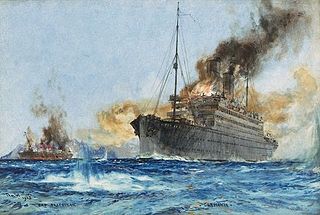
Merchant raiders are armed commerce raiding ships that disguise themselves as non-combatant merchant vessels.

An armed merchantman is a merchant ship equipped with guns, usually for defensive purposes, either by design or after the fact. In the days of sail, piracy and privateers, many merchantmen would be routinely armed, especially those engaging in long distance and high value trade.
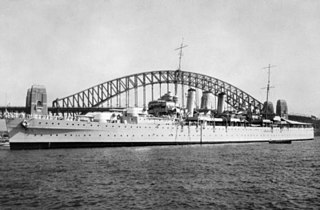
HMS Dorsetshire was a County-class heavy cruiser of the British Royal Navy, named after the English county, now usually known as Dorset. The ship was a member of the Norfolk sub-class, of which Norfolk was the only other unit; the County class comprised a further eleven ships in two other sub-classes. Dorsetshire was built at the Portsmouth Dockyard; her keel was laid in September 1927, she was launched in January 1929, and was completed in September 1930. Dorsetshire was armed with a main battery of eight 8 in (203 mm) guns, and had a top speed of 31.5 knots.

Komet (HSK-7) was an auxiliary cruiser of Nazi Germany's Kriegsmarine in the Second World War, intended for service as a commerce raider. Known to the Kriegsmarine as Schiff 45, to the Royal Navy she was named Raider B.

Widder was an auxiliary cruiser (Hilfskreuzer) of Nazi Germany's Kriegsmarine that was used as a merchant raider in the Second World War. Her Kriegsmarine designation was Schiff 21, to the Royal Navy she was Raider D. The name Widder (Ram) represents the constellation Aries in German.
Hellmuth von Ruckteschell was a German naval officer during World War II; he was one of the most successful merchant raider commanders of Nazi Germany, serving as the captain of the commerce raiders Widder and Michel. After the war Ruckteschell was convicted of war crimes and died in prison.

The Pinguin was a German auxiliary cruiser (Hilfskreuzer) which served as a commerce raider in World War II. The Pinguin was known to the Kriegsmarine as Schiff 33, and designated HSK 5. The most successful commerce raider of the war, she was known to the British Royal Navy as Raider F. The name Pinguin means penguin in German.

HMS Tuna (N94) was a T-class submarine of the Royal Navy. She was laid down by Scotts, Greenock and launched on 10 May 1940. She was equipped with German-built MAN Diesel engines and spent her career in World War II in western European waters, in the North Sea and off the west coast of France, and most famously taking part in Operation Frankton.
Michel(HSK-9) was an auxiliary cruiser of Nazi Germany's Kriegsmarine that operated as a merchant raider during World War II. Built by Danziger Werft in Danzig 1938/39 as the freighter Bielsko for the Polish Gdynia-America-Line (GAL), she was requisitioned by the Kriegsmarine at the outbreak of World War II and converted into the hospital ship Bonn. In the summer of 1941, she was converted into the auxiliary cruiser Michel, and was commissioned on 7 September 1941. Known as Schiff 28, her Royal Navy designation was Raider H. She was the last operative German raider of World War II.

Theodor Detmers was a German naval officer and captain of the German auxiliary cruiser Kormoran during World War II. He was a recipient of the Knight's Cross of the Iron Cross of Nazi Germany. Detmers commanded the commerce raider Kormoran when it sunk the Australian light cruiser HMAS Sydney in a mutually destructive battle.
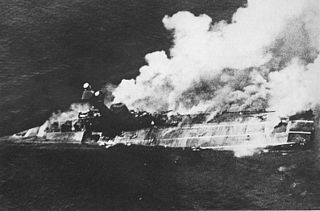
Prior to World War II, the Indian Ocean was an important maritime trade route between European nations and their colonial territories in East Africa, the Arabian Peninsula, British India, Indochina, the East Indies (Indonesia), and Australia for a long time. Naval presence was dominated by the Royal Navy Eastern Fleet and the Royal Australian Navy as World War II began, with a major portion of the Royal Netherlands Navy operating in the Dutch East Indies and the Red Sea Flotilla of the Italian Regia Marina operating from Massawa.
SS Automedon was a Blue Funnel Line refrigerated cargo steamship. She was launched in 1921 on the River Tyne as one of a class of 11 ships to replace many of Blue Funnel's losses in the First World War.
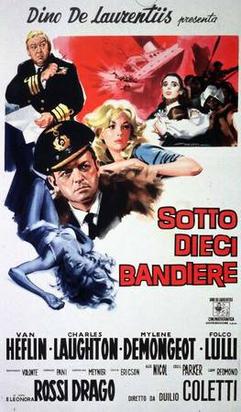
Under Ten Flags is a 1960 Italian-American war film directed by Duilio Coletti and starring Van Heflin, Charles Laughton, and Mylène Demongeot. It was entered into the 10th Berlin International Film Festival.
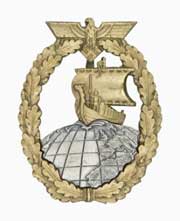
The Auxiliary Cruiser War Badge was a World War II German military decoration awarded to officers and men of the Kriegsmarine for service on Auxiliary Cruisers or the supply ships that supported them for a successful large voyage. The award was instituted on 24 April 1941 by Grand Admiral Erich Raeder.
Events in the year 1940 in Germany.
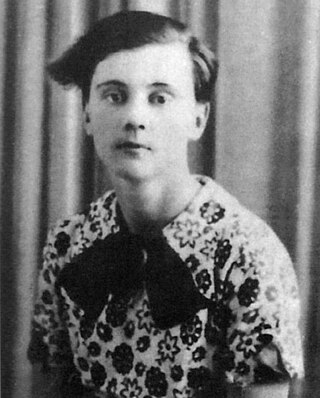
Susan Dorothea Mary Therese Hilton was a British radio broadcaster for the Nazi regime in Germany during the Second World War.
Arthur Victor Sellwood was a British journalist and author who specialised in twentieth century naval history, adapting the recollections of Second World War naval officers into popular history books. He co-authored the story of the German merchant raider Atlantis with that ship's adjutant Ulrich Mohr as well as "Hein" Fehler's account of the voyage of German submarine U-234 and T. J. Cain's story of service on H.M.S. Electra.

The SS City of Bagdad was a British merchant ship built for the Ellerman Lines that was captured and sunk by the German raider Atlantis on 11 July 1940.


















